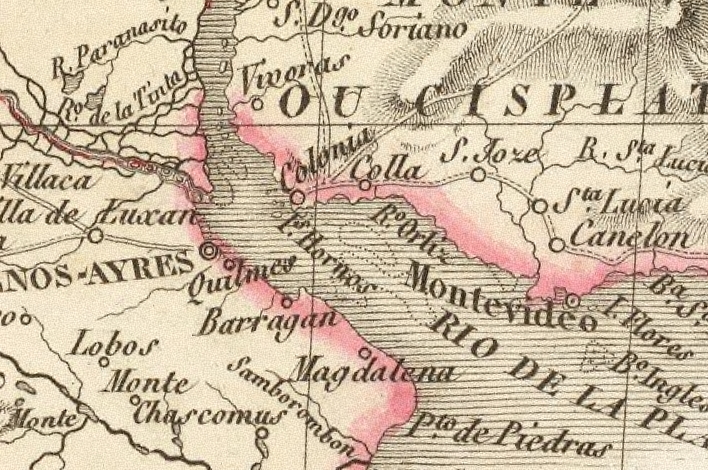|
Battle Of Punta Colares
The naval Battle of Punta Colares, also known as the Battle of Corales, was the first major naval engagement of the Cisplatine War. It took place between a fleet of the Empire of Brazil, commanded by admiral Rodrigo José Ferreira Lobo, and a squadron of the United Provinces of the Río de la Plata under the command of admiral William Brown. The confrontations began at around 10 o'clock on 9 February 1826 and lasted for seven hours. Background After war broke out between the Empire of Brazil and the United Provinces of the Río de la Plata on 10 December 1825, the Brazilian government responded by imposing a naval blockade on the port of Buenos Aires on 31 December 1825, aiming to cripple Argentine finances. Since then there had been no major naval engagements between both belligerent states. In the early morning of 9 February 1826 the Argetine squadron left the port of Buenos Aires and made its first attempt to break the blockade. Order of battle Empire of Brazil Un ... [...More Info...] [...Related Items...] OR: [Wikipedia] [Google] [Baidu] |
Cisplatine War
The Cisplatine War (), also known as the Argentine-Brazilian War () or, in Argentine and Uruguayan historiography, as the Brazil War (''Guerra del Brasil''), the War against the Empire of Brazil (''Guerra contra el Imperio del Brasil'') or the Liberating Crusade (''Cruzada Libertadora'') in Uruguay, was an armed conflict in the 1820s between the United Provinces of the Río de la Plata and the Empire of Brazil over Brazil's Cisplatina province, in the aftermath of the United Provinces' and Brazil's independence from Spain and Portugal. It resulted in the independence of Cisplatina as the Oriental Republic of Uruguay. Background Led by José Gervasio Artigas, the region known as the Banda Oriental, in the Río de la Plata Basin, revolted against Spanish rule in 1811, against the backdrop of the 1810 May Revolution in Buenos Aires as well as the regional rebellions that followed in response to Buenos Aires' pretense of primacy over other regions in the Viceroyalty of the Río d ... [...More Info...] [...Related Items...] OR: [Wikipedia] [Google] [Baidu] |
José Murature
José Félix Murature was a commodore of the Argentine Navy and a painter of Italian origin who served in several conflits including the Argentine Civil Wars, the Cisplatine War and the Paraguayan War. Arrival at the Río de la Plata Murtature was born in Genoa during the War of the Third Coalition. At the age of 11, he started as a midshipman on a French war frigate. During his youth he traveled in the Atlantic Ocean several times, reaching Brazil twice. In 1825 he arrived in Buenos Aires, a few weeks before the declaration of war by the Empire of Brazil. For a time, he worked with an uncle who owned merchant ships in Montevideo which was occupied by the Brazilians, and then returned to Buenos Aires. In January 1826 he enlisted in the fleet organized by Captain Guillermo Brown, and soon became an expert in river navigation on the Río de la Plata, Paraná and Uruguay. He was put in command of a small scout ship, which was very useful to Brown for information about ... [...More Info...] [...Related Items...] OR: [Wikipedia] [Google] [Baidu] |
1826 In Brazil ...
Events in the year 1826 in Brazil. Incumbents * Monarch – Pedro I Events Births * 10 January - Francisco Paulo de Almeida Deaths * 11 December - Maria Leopoldina of Austria References {{South America topic, 1826 in 1820s in Brazil Years of the 19th century in Brazil Brazil Brazil Brazil ( pt, Brasil; ), officially the Federative Republic of Brazil (Portuguese: ), is the largest country in both South America and Latin America. At and with over 217 million people, Brazil is the world's fifth-largest country by area ... [...More Info...] [...Related Items...] OR: [Wikipedia] [Google] [Baidu] |
Naval Battles Of The Cisplatine War
A navy, naval force, or maritime force is the branch of a nation's armed forces principally designated for naval warfare, naval and amphibious warfare; namely, lake-borne, riverine, littoral zone, littoral, or ocean-borne combat operations and related functions. It includes anything conducted by surface Naval ship, ships, amphibious warfare, amphibious ships, submarines, and seaborne naval aviation, aviation, as well as ancillary support, communications, training, and other fields. The strategic offensive role of a navy is Power projection, projection of force into areas beyond a country's shores (for example, to protect Sea lane, sea-lanes, deter or confront piracy, ferry troops, or attack other navies, ports, or shore installations). The strategic defensive purpose of a navy is to frustrate seaborne projection-of-force by enemies. The strategic task of the navy also may incorporate nuclear deterrence by use of submarine-launched ballistic missiles. Naval operations can be broa ... [...More Info...] [...Related Items...] OR: [Wikipedia] [Google] [Baidu] |


